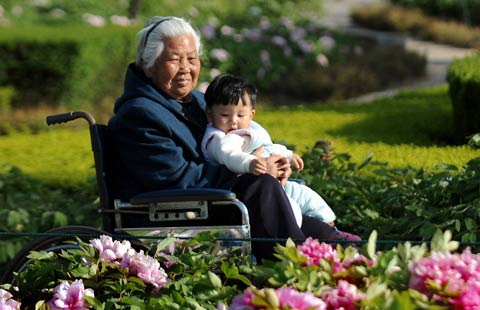Taking the path of pioneers
Updated: 2014-12-05 08:48
By Cecily Liu(China Daily Europe)
|
|||||||||||
For Chinese research and development, catching up is just a matter of time, expert says
Chinese companies are increasingly investing in research and development and becoming leading innovators globally, says George Yip, a professor of strategy at the China Europe International Business School.
Yip, who is also co-director of the CEIBS Centre on China Innovation, says Chinese companies are driven to innovation partly because of fierce competition in the domestic market and because of consumer demand.
|
George Yip, a professor of strategy at the China Europe International Business School, also co-director of the CEIBS Centre on China Innovation, says Chinese companies are driven to innovation. Cecily Liu / China Daily |
"Everything is trending upward in terms of Chinese science publication, technology intensity and foreign R&D centers," Yip says. "China is not at the stage of Western innovation like Germany and Japan, but it is rapidly catching up."
Yip says that at the root of Chinese innovation are many factors. First, the market is growing fast; secondly, it is competitive; third, the Chinese have different tastes so a lot of Western innovation no longer applies; and fourth, the market is diverse.
On the supply side, China has a lot of talent and low-cost R&D resources. The cost of hiring an engineer in China would be the same as a secretary in the Western world, Yip says.
The Chinese heavy machinery manufacturing company Sany, for example, is driven to innovation by China's tough terrain.
"China has so many building projects in different types of terrain, so Sany has to make the equipment that can carry the load," Yip says.
The Chinese white goods manufacturer Haier has also adapted this market-driven approach to innovation. It succeeded in the US market originally with small refrigerators suitable for student dormitories, and more recently it has produced refrigerators with a new temperature compartment that keeps ice-cream ready to eat.
"Haier showed a deep understanding of its American customers, maybe better than the Americans do," Yip says.
One key feature of Chinese innovation is practical application, he says.
Statistically, Chinese innovation is not large across the range, but some companies are leading R&D investors in their sectors globally, he says.
According to the EU Industrial R&D Investment Scoreboard, only three Chinese companies were in the top 100 globally in 2012, Huawei, PetroChina and ZTE, but each was a leader in its field.
In 2012, ZTE filed 3,906 Patent Cooperation Treaty patent applications, and Huawei filed 1,801, making them the first- and fourth-largest applicants that year. PetroChina invested $1.7 billion on R&D in 2012, more than any other oil and gas companies.
Yip has identified four stages of Chinese companies' innovation as they catch up from a low base: cost-driven innovation, adapting to the Chinese market, going global, and seeking new knowledge.
Chinese companies start with cost innovations, initially just to make products good enough and that fit into a niche, but the companies also have a deep understanding of customer needs, Yip says.
Examples include Baidu, Taobao and Tencent, Chinese Internet companies that innovate according to the needs of the domestic market, he says.
This stage of innovation also involves many adaptations of Western innovation to Chinese use, with minimal adaptations, Yip says. It has also driven reverse innovation, such as with GE Ultrasound technology, which was developed in Shanghai for the local market, but later applied by GE to other international markets.
The second stage transforms Chinese companies from followers to world class, because rising labor costs and competition demand a new strategy, pushing for customer-focused innovation, Yip says.
Often these innovations are incremental, such as enlarging a hotel lobby so Chinese leaders' big entourages have enough space to stand, or giving car back seats more leg room because Chinese leaders tend to sit in the back.
The third stage is the process of innovation abroad, which Chinese companies have to do as they venture into new markets, such as Haier's invention of the third refrigerator compartment and small refrigerators for university halls of residence.
The last stage is to achieve truly global innovation, particularly through the method of acquisition for brand and knowledge. Examples include Lenovo's buying Motorola Mobility, Dongfeng buying part of Peugeot-Citroen and Geely's buying Volvo.
These acquisitions allow Chinese companies to set up overseas R&D centers or take over existing R&D centers as a part of their acquisitions, and use the R&D resources to understand overseas customers and markets.
Despite growing Chinese investment in innovation, challenges remain that restrict major improvements in Chinese innovation and need to be overcome, Yip says.
"Some German car companies feel confident it will be hard for Chinese companies to catch up, because Chinese engineers did not grow up with fathers and grandfathers who took them to the auto repair garage," he says.
The solution to such shortages of talent is to bring overseas-educated people back to China and find ways to retain them, and Yip says the Chinese government has a good program aimed at doing that.
Yip, who grew up in Hong Kong, Burma (now Myanmar), and England, has a global education background, having studied at Cambridge University and later Harvard Business School.
He has worked extensively in industry and academia, and in 2011 he retired as dean of Rotterdam School of Management at Erasmus University. He was then invited to lead the new CEIBS Centre on China Innovation.
The center was built up with funding support from four multinational companies that all wanted to understand innovation in the Chinese market, AkzoNobel, DSM, Philips and Shell. They were later joined by other companies, including Beijing Benz Automotive Co, Bosch and the Chinese company Gome Electrical Appliances.
"We helped them improve and sped up their innovation processes, from a management perspective," Yip says.
Such techniques include reducing the number of referrals back to headquarters by giving autonomy to innovation managers and scientists.
"It's not easy to implement, as every company has processes. But they need to adapt and understand that innovation needs to be implemented fast, and they do not need to be 100 percent as good. This creates risks, and Western companies are risk averse."
Yip says many multinational corporations are increasingly shifting their R&D facilities to China. Initially they set up small units in China to localize and adapt products, but then reverse innovation takes place whereby technologies developed in China are then applied to other international markets.
Later, the accumulation of research expertise in China could mean the China R&D unit is given a regional or global mandate for some projects. Finally, as the China R&D unit becomes very efficient, some headquarters activities will be replaced completely by the R&D units in China.
Yip says this process, combined with constant innovation by Chinese companies, is making the country increasingly innovative.
China's innovation path is about 10 years behind that of South Korea and 20 years behind that of Japan, but will eventually emulate them, he says. But China also has the potential to be a world-leading innovator in infrastructure, such as high-speed rail and airports, because of the amount of infrastructure being rapidly built in China.
Yip says he is confident that innovation will change the image of Chinese brands in global markets in the future, so instead of being associated with low costs they will gradually become synonymous with quality and innovation.
"After all, China has only opened up since 1980 or so. We have had 35 years to move up the value chain. The first 10 years focused on low costs as an advantage, and now the focus is on quality, and the next stage will be innovation driven."
cecily.liu@chinadaily.com.cn
( China Daily European Weekly 12/05/2014 page32)
Today's Top News
US, Britain pledge to support Afghanistan
HK visit: A political kabuki
Ukraine unlikely to join NATO in near future
Hotpot chain to raise $129m
2014 likely to be record warmest year
Ukraine's ceasefire talks continue
China marks 1st Constitution Day
Outbound tourists hit record 100m
Hot Topics
Lunar probe , China growth forecasts, Emission rules get tougher, China seen through 'colored lens', International board,
Editor's Picks

|

|

|

|

|

|






